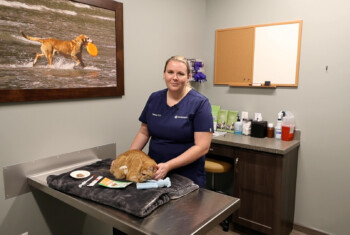If you’re looking for a guide on how to give your dog or cat insulin, you’ve come to the right place. Between your pet being diagnosed with diabetes to managing different types of needles and insulin, you may be feeling overwhelmed or intimidated. But administering insulin to your pet at home is key in managing your pet’s condition, so we’re here to help give you the information to confidently give your dog or cat their diabetes medication in the comfort of your home.
Video transcription.
Hello, my name is Rebecca Perkins. I'm a certified veterinary technician here at BluePearl Specialty + Emergency Pet Hospital. I'm here today to show you how to administer insulin to your pets at home.
Getting ready: Preparation is key.
Administering insulin is a key role in diabetes management. In that, make sure that your veterinarian has gone over with you what type of diet to feed your pet, as well as what kind of insulin you're going to be giving your pet.
With that in mind, go ahead and feed your pet what your veterinarian has recommended. Once you've fed them, make sure that they're in a comfortable spot so you can administer their insulin.
Types of insulin.
There's a couple of different types of insulins that you would be administering at home. And there's a couple of different ways to start handling those insulins.
One of the insulin types you would take and you're going to roll. Your veterinarian should go over this with you.

The other type of insulin you'd administer at home is one that you shake. Now, do keep in mind, when I say shake, I don't mean like a protein shake. I mean like a slow back and forth motion.

Types of needles.
The two different needle types that your veterinarian will go over is something called a U-100 or a U-40. These are two different units of measurement. It's very important that you give your pet the correct type of insulin with the correct type of needle.
Filling the needle.
Once you're ready to administer the insulin, you want to make sure that the bottle stays clean. Take an alcohol wipe – this is simply a cotton square with some alcohol on it – wipe the top of the bottle, and then you can get ready to administer your insulin.
- Take the cap off of the needle
- Insert the needle into the bottle
- Invert both
- Pull back as much insulin as your veterinarian has instructed
- Remove the needle
And you're ready to administer.
Giving insulin by yourself/administering insulin to a cat.
 This is Mikaela. She's one of the animals that's going to help us demonstrate how to give your pet insulin at home. Like I discussed earlier, make sure that they have a comfortable space for them to be on when you give them the insulin.
This is Mikaela. She's one of the animals that's going to help us demonstrate how to give your pet insulin at home. Like I discussed earlier, make sure that they have a comfortable space for them to be on when you give them the insulin.
For Mikaela, you can give her insulin in a couple of different spots. The most common spots are going to be right in between the shoulder blades as well as on the back end. Make sure you lift up the skin so you can make a tent. You want to make sure your finger goes inside just a little bit and you're not going to hit bone or anything like that.
Once you're ready:
- Prep your needle by taking off the cap
- Lift up the skin and make a tent
- Insert your needle and draw back a little to make sure you're not getting blood
- Administer the medication by pushing the syringe
- Remove your needle and recap it, then dispose of it appropriately
- Check for wet spots to ensure the medication went in
Giving insulin with a helper/administering insulin to a dog.

I've shown you how to give insulin with one person on a cat. Now we're going to be showing how to give insulin with two people. This is my friend and coworker Megan, who's going to be holding Wednesday today.
Once your pet is in a comfortable spot, like a blanket or their bed, have the friend or neighbor hold them in a way that's comfortable. Megan's holding Wednesday underneath her stomach and just in front of her chest. That's comfortable for Wednesday and I have a lot of room to work with on her side here.
Once you're ready:
- Uncap your needle
- Pull up a little bit of skin to make a tent and feel around for bone
- Inject the needle and pull back to make sure there's no blood
- Administer the insulin
- Recap and dispose of the needle
- Feel for wet spots to make sure all the medication has gone in
Rewarding your pet.
It's really important to reward your pet after you've given the insulin. Especially since diabetes is something that's most likely going to be lifelong. When I mention giving them a comfortable blanket, they know that's where they get love and possibly treats.
Discuss with your veterinarian as far as options to give them food if they're food motivated. Otherwise, giving them lots of love and their favorite toy directly afterward can be really helpful in this process.
Remember this when administering insulin to your pet.

Quick recap: How to administer insulin to your cat or dog.



